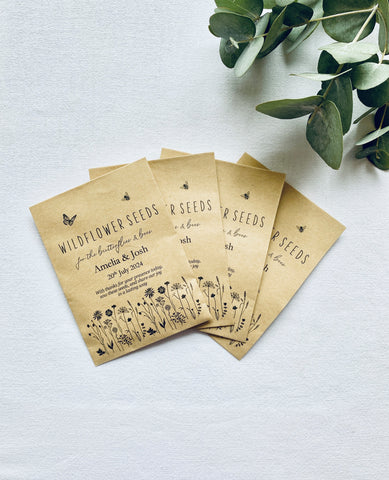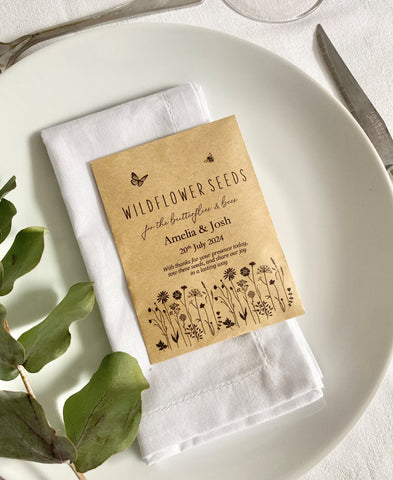The Beauty of Wildflower Seed Wedding Favours
Wedding favours often range from trinkets to edible treats however the idea of offering guests something more enduring and meaningful is increasingly appealing. Wildflower seeds have emerged as a charming and eco-friendly alternative to traditional wedding favours, capturing the essence of love, growth, and the beauty of nature. Here's why we think they're a great choice:
-
Symbolism of Growth and New Beginnings: Weddings symbolise the beginning of a new chapter in the lives of newlyweds, marked by growth, transformation, and the promise of a flourishing future together. Wildflower seeds beautifully encapsulate this symbolism, representing the seeds of love and the journey of growth and maturation that lies ahead. By gifting wildflower seeds, couples invite guests to share in the joy of their union.
-
Eco-Friendly and Sustainable: As awareness of environmental issues continues to grow, couples are increasingly drawn to eco-friendly wedding favours that reflect their commitment to sustainability. Wildflower seeds align perfectly with this ethos, offering a sustainable alternative to disposable trinkets or favours that may contribute to waste. By choosing wildflower seeds, couples demonstrate their respect for the environment and their desire to leave a positive impact on the planet, one seed at a time.
-
Personalisation: One of the most appealing aspects of wildflower seeds as wedding favours is the opportunity for personalisation. Couples can select a mix of wildflower seeds that hold special significance to them, whether it's flowers native to their wedding location, blooms that hold sentimental value, or a curated blend of colours and varieties that reflect their unique style and personality. Additionally, couples can personalise the packaging of the seeds with their names, wedding date, or a heartfelt message, creating a keepsake that guests will cherish long after the wedding day.
-
Long-Lasting and Memorable: Unlike many traditional wedding favours that may be consumed or discarded soon after the celebration, wildflower seeds have the potential to create lasting memories for both the couple and their guests. As guests plant and nurture the seeds, they become active participants in the couple's love story, watching as the seeds they received at the wedding grow into beautiful blooms that serve as a reminder of the joyous occasion.
-
Universal Appeal and Accessibility: Wildflower seeds possess a universal appeal that transcends age, gender, and cultural boundaries, making them a universally cherished wedding favour. Whether young or old, nature lover or novice gardener, guests of all backgrounds can appreciate the beauty and simplicity of wildflower seeds. Furthermore, wildflower seeds are accessible and easy to care for, making them an ideal choice for guests of varying levels of gardening experience.

The Benefits of Sowing Wildflower Seeds
Beyond their aesthetic appeal, sowing wildflower seeds offers a multitude of benefits for both the environment and gardeners alike, including:
- Biodiversity: Wildflowers attract a diverse array of pollinators, including bees, butterflies, and hummingbirds, thereby promoting biodiversity and supporting ecosystems.
- Low Maintenance: Once established, wildflower meadows require minimal upkeep compared to traditional lawns, reducing the need for water, fertilizer, and pesticides.
- Soil Health: The deep root systems of wildflowers help improve soil structure, prevent erosion, and enhance overall soil health.
- Conservation: Many wildflower species are native and play a vital role in preserving indigenous flora and fauna, making wildflower gardening a form of conservation.
How to Sow Wildflower Seeds
Preparation: Before scattering the seeds, proper preparation is essential to ensure optimal germination and growth. Here are the key steps to prepare for sowing wildflower seeds:
- Site Selection: Choose a sunny location with well-drained soil for your wildflower patch. Avoid areas with dense shade or heavy foot traffic.
- Soil Preparation: Loosen the soil to a depth of 4-6 inches using a garden fork or tiller. Remove any debris, weeds, or existing turf that may compete with wildflower seedlings.
- Soil Testing: Conduct a soil test to assess pH levels and nutrient content. Most wildflowers prefer slightly acidic to neutral soil (pH 6.0-7.0). Amend the soil accordingly with compost or organic matter if necessary.
- Seed Selection: Select a diverse mix of native wildflower seeds suited to your region's climate and soil conditions. Consider factors such as bloom time, height, and colour variety to create a dynamic and visually appealing meadow.
Sowing: With preparations complete, it's time to sow your wildflower seeds and watch nature take its course. Follow these steps for successful seed sowing:
- Timing: The ideal time to sow wildflower seeds varies depending on your region's climate and the species you're planting. In temperate climates, early spring or late fall are optimal times for sowing, while in warmer regions, seeds can be sown in late fall or early winter.
- Seed Distribution: There are several methods for distributing wildflower seeds, including broadcasting, hand sowing, or using a seed spreader. Choose a method that ensures even coverage and prevents overcrowding.
- Seed Depth: Most wildflower seeds require light to germinate, so it's essential not to bury them too deeply. Lightly press seeds into the soil surface or gently rake them in, ensuring good seed-to-soil contact.
- Watering: After sowing, water the area lightly to settle the seeds into the soil. Use a fine mist or gentle spray to avoid displacing seeds. Continue to water as needed to keep the soil consistently moist but not waterlogged until seedlings emerge.

Establishing and Maintaining Your Wildflowers: Patience is key as you wait for your wildflower patch to flourish. Here are some tips for establishing and maintaining your meadow:
- Weed Control: Keep an eye out for invasive weeds and remove them promptly to prevent competition with wildflowers. Hand pulling or spot treatment with natural herbicides can help keep weeds at bay.
- Thinning: As seedlings emerge, thin out overcrowded areas to allow for proper airflow and prevent damping off disease. Aim for a spacing of 6-12 inches between plants, depending on the species.
- Mulching: Consider mulching the area with organic materials such as straw or wood chips to retain moisture, suppress weeds, and protect emerging seedlings from temperature fluctuations.
- Fertilisation: Avoid fertilising your wildflower patch, as excess nutrients can encourage aggressive weed growth and disrupt the natural balance of the ecosystem.
- Mowing: Once your wildflowers have established and bloomed, adopt a "mow high, mow infrequently" approach to maintenance. Allow wildflowers to set seed before mowing, and mow at a height of 6-8 inches to promote root growth and preserve habitat for pollinators.
- Enjoyment: Finally, take time to enjoy the beauty and biodiversity of your wildflower patch. Observe the myriad of pollinators it attracts, and revel in the ever-changing tapestry of colours throughout the seasons.
Our Dried Flower Rose Pew Ends offer a delicate and rustic adornment that will bring a touch of natural beauty to your special day. This enchanting pew decoration is crafted with love, featuring gypsophila, eucalyptus variations, and a faux rose, all elegantly tied off with white organza ribbon.
Key Features:
-
Rustic Elegance: Our Dried Flower Pew Ends effortlessly captures the essence of rustic charm. The combination of gypsophila, eucalyptus variations, pampas, corn and a faux rose showcases a rustic elegance that will beautifully compliment any wedding theme.
-
Natural Beauty: The inclusion of delicate gypsophila, aromatic eucalyptus leaves in various shades, and the unique texture of thistles gives this pew end a natural and ethereal beauty that adds a touch of enchantment to your wedding venue.
-
Versatile: These pew ends can be easily attached to the pews at your ceremony venue, and they also work beautifully as aisle markers. Use them to line the path that you'll walk down, creating a captivating entrance.
-
Customisable: We understand that personalisation is essential for your special day. You can choose the colour of the rustic ribbon to match your wedding colour scheme, making this pew end a truly bespoke addition to your décor.
-
Timeless Keepsake: Unlike fresh flowers, our dried flower pew end will remain beautiful long after your wedding day. It can be kept as a cherished keepsake, reminding you of the love and memories you shared on that special day.
-
Eco-Friendly: We're committed to sustainability. By using dried flowers, we reduce waste and environmental impact, making this pew end a thoughtful choice for eco-conscious couples.






